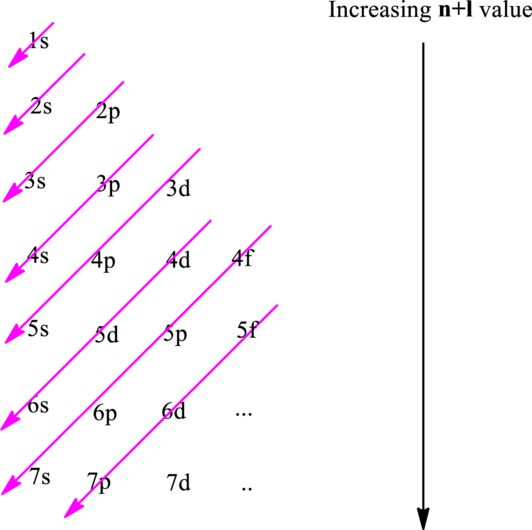
(a)
Interpretation:
The
Concept Introduction:
The fundamental principles that are followed to write an electronic configuration include three rules as follows:
Electron in a

Hund’s rule suggests electrons are not allowed to be paired up until each degenerate set of orbital has got at least one electron.
Pauli Exclusion Principle states two electrons within the same orbital cannot possess same set for four possible quantum numbers. Quantum-mechanical equivalent for this state means that two electrons are not allowed to have the same space simultaneously. Since one electron may certain discrete same set of n, l and m values, however, the fourth spin quantum number should be different. This provides a unique address to every electron. Since the possible magnitudes of spin can be either +1/2 or -1/2 thus at maximum two electrons can occupy any given orbital.
The convention followed to remove or add electrons is electrons of largest principal quantum number are lost first. In case of subshells of the same
(b)
Interpretation:
The
Concept Introduction:
Refer to part (a).
(c)
Interpretation:
The
Concept Introduction:
Refer to part (a).
(d)
Interpretation:
The
Concept Introduction:
Refer to part (a).
Want to see the full answer?
Check out a sample textbook solution
Chapter 2 Solutions
Chemical Principles: The Quest for Insight
- Use the periodic table to (i) predict electron configurations for the following species: Arsenic ion, As3– Magnesium ion, Mg2+ Vanadium(II) ion, V2+ (ii) Write the electron configurations of each species in the noble gas notation. (iii) Draw an orbital diagram to represent 1 c above. Draw the Lewis electron dot structures of the following chemical species. In each case you must say whether or not the central atom obeys the Octet Rule. CS2 and H2S CF4 and SiH4 NH2Cl CO32– and BF3 PCl5 ClF3, XeF2, Calculate the formal charge on the Sulphur atom in the Sulphate anion structure shown below(picture attatched) Give the electron-pair and molecular geometries for NF3 and XeF4.arrow_forwardIdentify two ions that have the following ground-state electronconfigurations: (a) [Ar], (b) [Ar]3d5, (c) [Kr]5s24d10.arrow_forwardWrite down the uncondensed electronic configurations for Co;; Co2+ and Co3+. In the case of the Co2+, which orbital is losing electrons? Why is this the case?arrow_forward
- 2. Which one of each of the following pairs has the higher ionization energy? Explain in detail for each case. (a) Na or K (b) Ве or B (с) В or C (d) N or O F or Ne (f) Mg or Mg* Ne or Naarrow_forwardA.) What is meant by the term polarizability? B.) Which of the following atoms would you expect to be most polarizable? O2, S, Se, or Tearrow_forwardFor each of the following pairs of atoms, state which youexpect to have the higher electron affinity: (a) Rb or Sr;(b) I or Rn; (c) Ba or Te; (d) Bi or Carrow_forward
- 2. Explain the following phenomena on the basis of electron configuration. i) Fluorine forms an ion having a charge of -1. Support your answer by providing the electron configuration of both atom and ion. ii) Which is the more likely the configuration for Mn2+: [Ar]4s23d3 or [Ar]3d5. Give reason for your answer.arrow_forward7. Which element has the smallest first ionization energy? (a) Cs (b) Ga (c) K (d) Bi (e) As 8. Which element has the smallest second ionization energy? (a) Mg (b) Li (c) S (d) O (e) Ca 9. Which of the following sets contain all linear molecules? (a) H2S, HCN, CO2. (b) HCN, O2, CO2 (c) H2O, CO, Cl2. (d) H2S, CO, CO2. (e) BF3, Cl2, O2 10. The molecular geometry of SnCl3-ion is: (a) trigonal planar (b) T-shaped. (c) trigonal pyramidal. (d) Tetrahedral (e) see-saw 11. The geometry of the molecule SPC13 is best described as: (a) square planar (b) trigonal pyramidal (c) trigonal bipyramidal. (d) octahedral (e) tetrahedral 12. The O-S-Cl bond angles in O2SCl2 are expected to be approximately: (a) 90° (b) 109.5° (c) 120° (d)180 ° (e) 90° and 120°arrow_forwardThe gadolinium +3 ion (Gd3+) has advantageous magnetic properties for Magnetic Resonance Imaging (MRI) applications, specifically a high number of unpaired electrons. In fact, both neutral Gd and Gd3+ have a set of degenerate orbitals with seven unpaired electrons. a) Write the electron configuration for Gd and Gd3+ using the condensed noble gas notation. Identify which orbitals lose electrons to yield the +3 cation based on the above information. Explain your reasoning (2-3 sentences). b) Curium (Cm) is an actinide element named for Marie Curie. Cm is in the same group as Gd and also forms a +3 cation. Write the electron configuration for Cm and Cm3+. c) While +3 is the most common oxidation state for lanthanide elements, some can form +2 ions. Identify an isoelectronic ion to Gd3+ that has a +2 oxidation state and indicate which orbitals lose electrons to form that ion.arrow_forward
- For each pair, identify the orbital in which an electron possesses more energy. (a) 4s or 5s; (b) 5p or 5darrow_forwardWrite the charge and full ground-state electron configuration of the monatomic ion most likely to be formed from each atom: (a) CI (b) Na (c) Ca Which of the formed ions will be least stable? -- --arrow_forwardArrange the following iso-electronic species in order of increasing ionic radius: Br –,Sr2+, As3–. Give a brief explanation why you chose this arrangement.arrow_forward
 Chemistry: The Molecular ScienceChemistryISBN:9781285199047Author:John W. Moore, Conrad L. StanitskiPublisher:Cengage Learning
Chemistry: The Molecular ScienceChemistryISBN:9781285199047Author:John W. Moore, Conrad L. StanitskiPublisher:Cengage Learning Physical ChemistryChemistryISBN:9781133958437Author:Ball, David W. (david Warren), BAER, TomasPublisher:Wadsworth Cengage Learning,
Physical ChemistryChemistryISBN:9781133958437Author:Ball, David W. (david Warren), BAER, TomasPublisher:Wadsworth Cengage Learning, Chemistry & Chemical ReactivityChemistryISBN:9781337399074Author:John C. Kotz, Paul M. Treichel, John Townsend, David TreichelPublisher:Cengage Learning
Chemistry & Chemical ReactivityChemistryISBN:9781337399074Author:John C. Kotz, Paul M. Treichel, John Townsend, David TreichelPublisher:Cengage Learning


